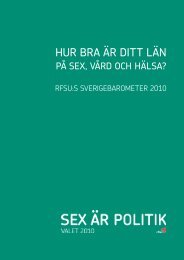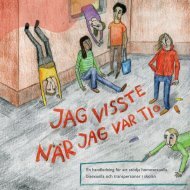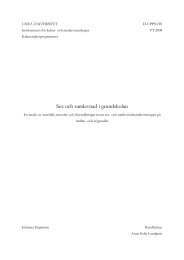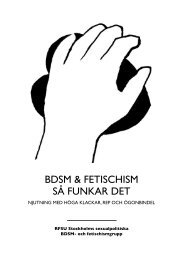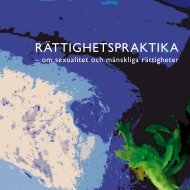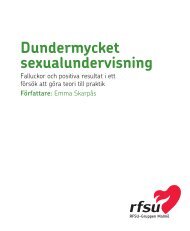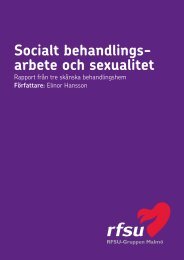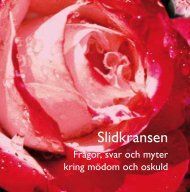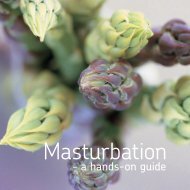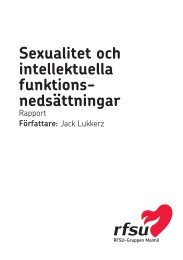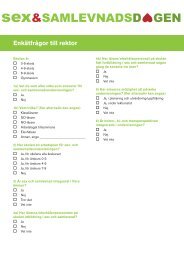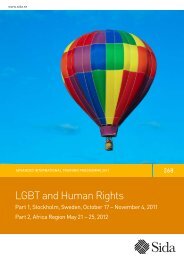Download pdf - RFSU
Download pdf - RFSU
Download pdf - RFSU
Create successful ePaper yourself
Turn your PDF publications into a flip-book with our unique Google optimized e-Paper software.
transitional phenomenon and create a fear of developing<br />
autonomous means of regulating tension and<br />
discomfort. The child’s ability to be alone, even if the<br />
mother is present, can thereby be undermined. A further<br />
consequence may be that the child must assure himself<br />
of the mother’s presence in order to be able to cope with<br />
different feeling-states, regardless of their internal or external<br />
origins.<br />
Given such circumstances it may be difficult for the<br />
child to develop an inner representation of a caring maternal<br />
figure. A figure that encompasses the ability to cope<br />
with both psychological pain overwhelming emotional<br />
stimulation. If a child is not able to identify with and<br />
internalise such a figure it becomes incapable of developing<br />
a self-soothing function and limits the ability deal<br />
with internal and external pressures. As a result, regulative<br />
functions tend to be sought in the outside world. Drugs,<br />
food, sex, and exposing oneself to physical danger or pain<br />
can be used as a ways of regulating inner feeling-states<br />
and diverting conscious awareness of inner pain. The<br />
problem is, however, that the use of such behaviour as<br />
regulative functions acts primarily in physiological rather<br />
than psychological terms. They are somatic attempts to<br />
compensate for something that is missing psychologically.<br />
As such they can only lend temporary relief.<br />
When such a void in early relationships exists, the<br />
ability to recognise, understand and deal with inner experiences<br />
may be seriously impaired. Desires, needs, and<br />
impulses become expressed in actions, without thinking.<br />
Consequently, the ability to use one’s mind in order to<br />
determine whether this is good or bad is eliminated.<br />
Repeating early trauma<br />
The experience of being abused as a child, whether<br />
sexually, physically or psychologically, is impossible to<br />
understand or even think about without help. Instead of<br />
being felt and integrated psychologically, such experiences<br />
become deposited in a kind of chaotic isolation. They exist<br />
as inner disasters without meaning. The individual will<br />
continuously return to the unintegrated raw experience<br />
of these disasters by expressing it in actions.<br />
The trauma becomes constantly reformed and re-expressed<br />
in new ways be in an effort to win control over<br />
the experience and thereby eliminate the feelings of inner<br />
chaos. From the experience of being a dependent and<br />
passive victim an illusion of power and control over the<br />
trauma is born. In this way passive is turned to active, and<br />
the individual becomes the director of his own drama.<br />
By directing the drama, it becomes possible to find<br />
revenge and triumph. The victim now becomes perpetrator,<br />
and can empty his emotional pain into another victim.<br />
Here it is important to understand that this dynamic involves<br />
an attempt to find a solution to inner problems by<br />
ridding the individual of unbearable feelings. However,<br />
since it does not constitute an actual solution involving<br />
psychological growth that can heal a damaged inner world,<br />
the act must be repeated.<br />
The men and women taking part in the project<br />
described a wide variety of traumatic experiences that<br />
occurred early in life, such as various form of separation,<br />
abandonment, neglect, psychological, physical or sexual<br />
abuse.<br />
A common experience was a feeling of being left to<br />
the whims of one parent. Fathers were often described as<br />
absent, either physically or emotionally through their passivity.<br />
Growing up with two parents (or other adults) who<br />
have a reasonably good relationship to each other, helps<br />
to engender an inner model in which a good relationship<br />
22



